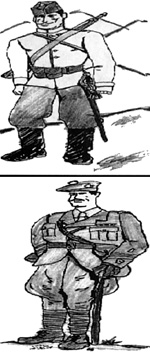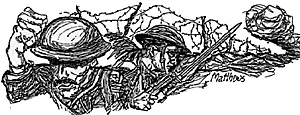
World War One is often written off in wargames articles. Those that admit to an interest must always say that they only do Southwest Africa or Lawrence of Arabia. Others only do skirmish games. I think this is an interesting era of massed armies. I like trenches, machine guns, gas, and stupid and callous generals.
This is the classic "rich man's war and poor man's fight". Society collapsed because feudalism is wrong and people are worth something.
The Western Front was hell on earth and there is something to be said of fat drunken generals and Winston and the Czar having people brutally killed for money and power.
Here are a few notes on WWI; they might not be totally accurate as I'm just starting to study the era, then line up the troops and learn why this was the "war to how people never learn."
GREAT WAR
Divisional organizations were fairly standard and some changed as the British had two battalions per regiment; two regiments per brigade and tdivision. Later in the war, just nine battalions plus one pioneer battalion. The Russians had eight battalions per brigade and two brigades per division. The French started with six battalions per brigade and two brigades per division;nine battalions.
The Germans had six battalions per brigade and two brigades per division, as did the Austrians. Later in the war, the classic WWII nine battalions per division appeared.
The USA had twelve battalions per division and also a machine gun battalion. The US divisions were twice as large as the allies at about 28,000 men.
The Ottomans probably copied the Germans. I have read nine battalions in three regiments per division. The Italians were essentially the same as the French.
As you can see, most divisions had twelve battalions except the R sixteen in the early war. I'm assuming the American divisions were kept up to strength and many had service troops to account for their size. In the last two years, the British seemed to have dropped to nine battalion divisions due to manpower shortages, as did the Germans.
UNIFORMS
I have looked at many color pictures and drawings and the thing that strikes me is the lack of uniformity in colors despite the old saying that everyone wore "khaki". Khaki is a highly variable term.
Britain wore a greenish or brownish khaki with black shoes. I've seen more light brown pictures than greenish' more green later in war.
The Russians are variable. They were said to wear olive khaki, however, I have seen light green shirts and pants, olive pants, and light brownish shirts. The greatcoat could be khaki, greenish, or gray. Boots are black. Caps are peaked but it is said the Czar was given two million Adrian helmets.
France started the war in France with Prussian type dress and switched to horizon blue; the pants are lighter than the coats. Adrian helmet.
Italy wears green; greener than field gray. Adrian helmet.
Ottomans wore light khaki with wood helmets with wrapped khaki.
Austrians wore pike gray which I have seen as light gray or in a drawing, a light blue. I have a photo where the gray is light gray. Later in the war, they had some German field gray and even some Italian green. Brown boots, high pulled cap, or green helmet.
The Germans wore field gray which is green that fades to gray. Coal scuttle helmet or pickelhaube in the early war. Machine gun troops wear green. Boots were black.
The USA wore olive drab which is greenish khaki although some troops wore British uniforms partly. The Marines started in forest green, but were made to switch to olive drab to avoid mess-ups with field gray. They painted/affixed Marine Corps insignia on their helmets, which were the British type.
Thus, uniforms were not as uniform as they are today.
MINOR NATIONS
The Bulgarians were very similar to the Russians while the Serbians wore a fez-like hat indented in the middle.
ARTILLERY
It appears as though most divisions had 48 attached artillery pieces, however, I have read that some German divisions had 72 or 96 guns. It is usually quoted that the Germans had twice as many guns as the Russians per division.
The Italians and Ottomans may have been a little light in artillery for much of the war. One source states that the Russians had 48 pieces to the Germans 72. Ammunition was low in the Russian Army and plentiful as a rule in the German Army. The United States had 72 guns; 48 light and 24 heavy. All were French models.
A wargamer's rule of thumb might have 48 guns per division with many more added at the corps and army level for "big pushes."
As far as machine guns, in the early war most armies had two per battalion. Later on in the war, there were many more, but they seemed to be grouped at higher levels of command and attached when needed.
INTERESTING SPECIAL UNITS
 Britain had Highlanders, Colonials and jaunty Canadian, Aussie and New Zealand units.
Britain had Highlanders, Colonials and jaunty Canadian, Aussie and New Zealand units.
Russia had some Guards, Cossacks in blue pants. Nicholas sent a division to the Western Front and they all spoke French, wore Adrian helmets, and some French gear. Some sources said they "revolutionalized" and were destroyed by French artillery in the back lines.
Germany had storm troops in armor and machine gun troops in green.
The French Legion was the most decorated march regiment. They wore Colonial khaki like all the Colonial troops. The Colonials were feared; the Senegalese were giants in khaki and carried large knives.
The Ottomans had Turkish and Arab troops. Some wore German uniforms. The Austrians had Jaegers in hats and Bosnians in a fez.
The Italians had Arditi storm troopers, Bersayheri and Alpini wore special hats and were good at mountain warfare.
VARIOUS THEATERS OF WAR
There were many theaters of war including the Eastern Front, South Africa, Arabian desert, Gallipoli, Italy, Russian Revolution, the War in the air, Western Front, Tanks, Gas, Carrier Pigeons, Irish 1916 uprising, Zeppelins, and the Fleets at Jutland.
SOURCES
Phillip Haythornthwaite's excellent books; Alastair Horne on Verdun; Guns of August video.
SOURCES FOR 15MM TOY SOLDIERS
MINIFIGS has excellent USA, French, German, Russian, Austrian and Ottomans as well as some guns and vehicles.
IRREGULAR of England: If you call the British Isles, this company has excellent ground troops and superb guns and AFV's. Even with phone call, price and shipping, you get your troops in a very quick time and they are less expensive than you would think for such fine quality. They take credit cards as well.
ROYAL OAK MINIATURES have excellent mealie bags that I use for trenches. Fred Bultman is a true gentleman and scholar.
Back to MWAN #92 Table of Contents
Back to MWAN List of Issues
Back to MagWeb Magazine List
© Copyright 1998 Hal Thinglum
This article appears in MagWeb (Magazine Web) on the Internet World Wide Web.
Other military history articles and gaming articles are available at http://www.magweb.com